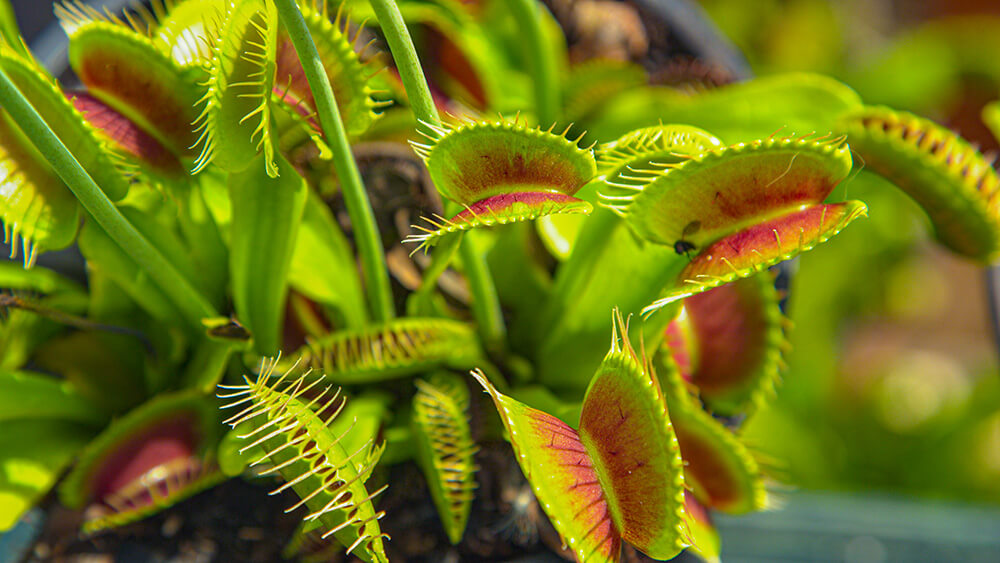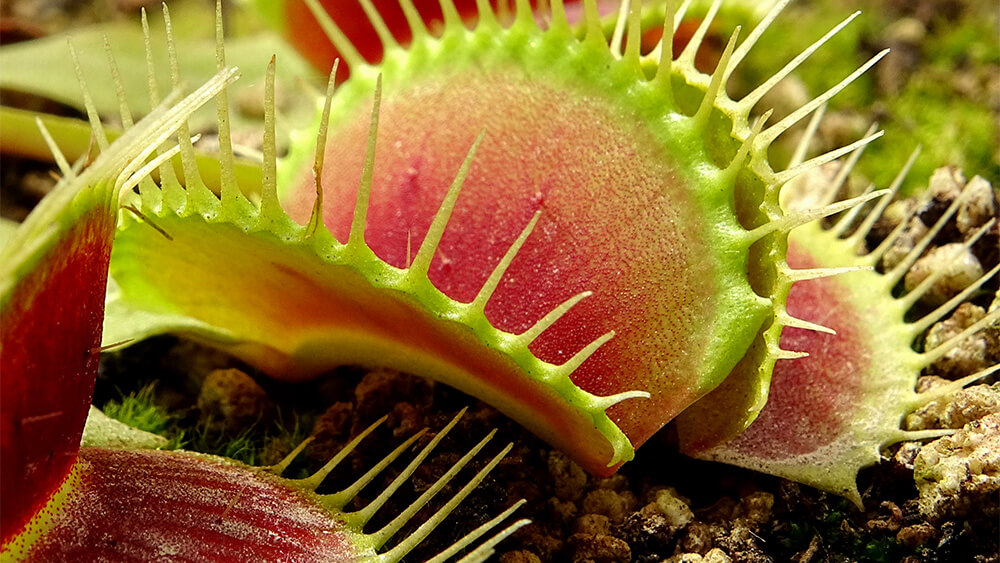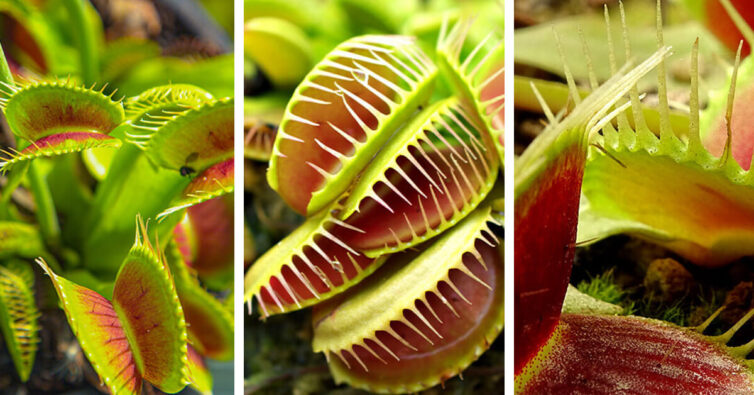When you look at the “teeth” on a Venus Flytrap, they might not surprise you that they eat insects, but do you know why? Bugs provide this plant with nutrients they can’t get from the soil: this is essential for Venus Flytrap care. And don’t let their exotic look fool you. They’re native to North and South Carolina! An amateur botanist, Governor Arthur Dobbs, discovered it in 1759. He’d never seen anything like it before. His awe and amazement quickly set the botany world afire.
What is Venus Flytrap?
Venus flytraps only grow naturally within a 75-mile radius of each other. Apparently, for them, there’s no place like home. They only travel with merchants supplying this plant to stores in USDA Hardiness Zones 6a to 10a.
The flytrap does not have a mind to control the movements of its mouth. Instead, it reacts to touch. Insects interacting with little hairs in Venus Flytraps activate the snapping mechanism. It takes several touches before the mouth closes and with good cause.
There is a limit as to how many times the Venus flytrap can open and close. The plant reduces energy consumption, focusing on better chances of a live meal.
Just lil’ ol’ Me: The Venus Flytrap has a monotypic genius. Meaning it is the ONLY species within the genus. As more studies emerge, it appears the plant may have some relationship with sundews. (the droseraceae family)
Key Takeaways
- The water from your tap is usually too alkaline. You’re better off with rainwater or distilled water.
- You can give your Venus Flytrap dead bugs, but you must activate the closing mechanism using a small paintbrush or something similar.
- If you’re looking to buy a Venus Flytrap, your best bet is through specialty nurseries.
- A 2014 change in state laws made it a felony to poach the Venus Flytrap. They have not as yet appeared on the threatened or endangered species list.
Points to Venus Flytrap Care and Growth Indoors
The more you learn about plants, the more you’ll discover some underlying commonalities. There are five key points to focus on when caring for your indoor Venus flytrap.
- Light: These plants thrive their best when they receive six hours a day of bright sunlight. Peek inside the trap area. If it’s not pink, it needs more light. If you’re using grow lights, make sure your pots are about 6 inches away.
- Soil and Dampness: The traps are not terribly soil-picky. They don’t mind poor soil with acidity so long as it has good drainage. Avoid “tropical plant” soil. Instead, look for brands designed explicitly for the Venus Flytrap.
- Heat and Moisture: A Temperature range of 70 to 95 F proves ideal for these plants. With protection, however, some plants will bounce back from the 40s so long as you protect them. Add humidity using a small dehumidifier system. A fan running in the rooms where you display the trap plant keeps the air circulating.
- Fertilizer: NOPE. Nada. The Venus flytrap should get all the nutrients they need from insects.
- Food: In place of fertilizer, give your indoor flytraps small bugs (like flies and beetles). Make sure the feed is no larger than ⅓ the size of the trap itself. The mouth can’t close enough in order to digest the provided food. Don’t let people play with your plant. Only touch it when there is food prepared.
Just because bugs have protein doesn’t mean your Venus Flytrap will respond positively to other kinds of meat. No chicken, no steak, no hot dogs, and oh… no candy or fruit.
Indoor Venus Flytrap Care and Needs

Following the venus care guidelines provided, you should have fair success in keeping the plant healthy. You do have to be willing to put in the time to learn, or you may see a decline within a few months.
You are basically trying to recreate conditions within your home that are the same as its natural habitat. Take care with the water you use, as these plants are susceptible to minerals.
You won’t have to hunt too often for bugs. During the growing season, they only need a couple a month. Don’t panic if the pants die back come winter months. That’s normal dormancy, and they’ll revive with sprouts come spring.
If you live in an area with cold winters, make sure the Venus flytrap is well away from drafty areas.
Pollinator Indemnity: Studies into the Venus flytrap show that the plant may be picky about its prey. The traps rarely consume pollinators hovering in flowers above. Crawling insects appear more favorable.
Venus Flytrap Choices for Your Home
Dionaea muscipula (the Venus Flytrap) has different cultivars with a variety of amenable traits. Their coloration names many, like “purple haze” or “red dragon.” More often than not, you’ll only find these in specialty plant nurseries.
B52: A widely circulated cultivar with large traps (1.5”). The inside of the B52 is a dark pink-red all the way to the tips
Cupped Trap: This Venus Flytrap has traps cupped at the tip. It grows to between 2 and 4 inches. Their centers are pink-red, with bright green borders.
Fused Tooth: These grow white flowers, which look lovely against the leaves. Those appear to be orange-green in the center with a spring-green interior.
Green Dragon: While this Venus Flytrap is sometimes called Red Dragon, the margins of the plant are definitively green. It measures 4” at maturity. Sunshine is fine, but try to plant it where it won’t get overheated.
Jaws: As you might expect, this Venus flytrap has a shark-like appearance when closed. It sports blood red centers topped with yellow and a green border. The red cultivar of Jaws Venus Flytrap has a mature height of 6 inches.
Justina Davis: If you love green, Justina Davis delivers it in every inch. It is one of the most hardy Venus flytraps you’ll find. Border it with something like the Red Sunset for an impressive visual.
Petite Dragon: This Venus Flytrap has an interior color resembling crushed wine velvet. A demure plant, growing to just over ½”.
Red Piranha: More of a ruddy red than bright in the center. The edges are pea-green. Mature height 2-4”.
Red Sunset: True to its name, the Red Sunset is always cheerfully red. Its petioles are skinny and long. In winter, it loses all its leaves. Grows to be a dainty 2” tall plant bearing pretty white flowers.
Wacky Traps: This plant has incompletely developed leaves. It grows very slowly. Even the flowers are distorted, splayed like a white star.
In North Carolina, Venus Flytraps are considered a “species of special concern.” Responding to the need for protection, the State made it a felony to poach them in 2014.
Watering Techniques for Venus Flytrap

Moisture is a keynote in Venus Flytrap care. These plants originated in boglands. If the soil dries out too much, the plant will die. An easy way to water your plant begins with a saucer of water. Put the pot into the saucer for a few hours, every 3 (ish) days.
The plant soaks up the water from the bottom like a sponge. When the air is particularly dry, check your flytrap regularly to make sure the medium is retaining moisture.
I Blossom! When you picture the Venus Flytrap in your mind, all that comes to the forefront is a toothy mouth plant. But they produce pretty flowers perennially.
Potting and Repotting
When you go to pot or repot a Venus Flytrap, remember these plants have energy-storing rhizomes. They look like white bulbs entangled in the roots. You can use these to grow new plants.
Most Venus Flytraps benefit from annual repotting in order to keep the media fresh and light. You can repot this plant nearly any time you want, but spring and summer are best. Just avoid repotting if your flytrap is actively flowering.
Have everything ready for your Venus Flytrap when you get home from the nursery. The watering system does not cater to this plant’s need for filtered water. Just get rid of the old media, and start out fresh. While you’re shopping, grab some carnivorous plant soil mix.
Also, look for a deep pot (say 4”) for solid root growth and development and one with drain holes.
In the house, keep them away from areas with high heat or cold (like air conditioning ducts); Your plant may seem slow at the start, but it’s just adjusting to the new environment.
The bright red color inside a flytrap’s lobes isn’t just for show. The color attracts insects. Venus Flytraps produce sweet nectar as a lure, too. Once the bug is firmly in the trap, enzymes drown them, and it’s ready for lunch!
Pruning and Maintenance
Prune away dead growth in spring or early summer. Take the leaves off at the base. True fact: the trap of the plant can only open and close for a limited amount of time before they die. But, as a leaf dies, they produce a new one.
If you see a leaf browning, don’t prune it immediately. Wait until it’s fully withered. As for the flowers, once spent, trim the stalks out. Always use scissors for this task. Think gentle. Take care not to activate any of the traps.
A Break for Digestion: It takes a while for the Venus Flytrap to digest its food. It has to break down the entire meal and absorb the nutrients.
So this plant may still be enjoying its meal for several days and in some cases, weeks. Now the Venus Flytrap can just relax for a few months before it needs to eat again.
Blooming and Resting Periods
Come late fall and winter, the Venus Flytrap slowly shuts down for a dormant. Even indoor plants may slow down following Mother Nature’s lead. During this period, don’t panic if leaves die quickly and a small rosette remains. Growth may stall. But come the spring, they’ll grow back to normal.
It’s essential for your plant to get about 10 weeks of downtime for a healthy new season. Without it, they will weaken and can even die.
Venus flytraps may harm flies but are harmless to pets and people. While they may look imposing, this plant has no teeth. The prongs are merely a cage for capture. If you stick your fingers in a trap, you’ll feel only pressure when it closes.
Common Pests and Plant Diseases

Venus Flytraps may have issues with spider mites, aphids, or fungus gnats. Aphids distort the leaves around the crown. re easy. Just dump the plant into distilled water. Wait two days. Once removed, stay aware. You may need something like Neem Oil if this doesn’t work. A bonus here is this approach works on spider mites, too.
Fungus Gnats are annoying as adults, but their larvae do much more harm. They dig into plant stems and roots, weakening the system. In turn, fungus may develop. Dunking the plant in water can drown them.
Gray Mold may occur in the Venus Flytrap, too. It looks a bit like what you see on old bread. The leaves seem to have water spots. The affected parts wilt and fall off. High humidity spreads spores, making your plant even more sick. Cut off any infected areas, and move the plant into fresh soil.
A Divine Influence: Venus Flytrap plants are named after a Goddess. Venus is the Roman Goddess of love and beauty. Why? Because there are stories of Venus fashioning a gold net to catch unfaithful lovers.
Troubleshooting Common Venus Flytrap Problems
Wilting: This may arise when the plant is underwatered or too hot. Make sure your plant has some shade in the afternoon, and add more water.
Yellowing: While various issues can lead to yellowing leaves, the spider mite is one of the main culprits. If you see webbing, you know for sure.
Viruses can create yellowing or yellow spots too. If your flytrap has yellow-edged leaves, you can alleviate the problem with more magnesium. Green veins on yellow leaves are a sign of low iron.
We know that the Venus Flytrap comes from North and South Carolina. They are content with this location. The plants do not appear naturally anywhere else in the world.
Summary
The Venus Flytrap is not for everyone. It’s persnickety and fairly easy to kill if you’re not paying attention. Once you’ve got the hang of it, you can enjoy the plant’s quirky visage and maybe even get to see it catch an insect. For your indoor garden, this is a curiosity piece.


